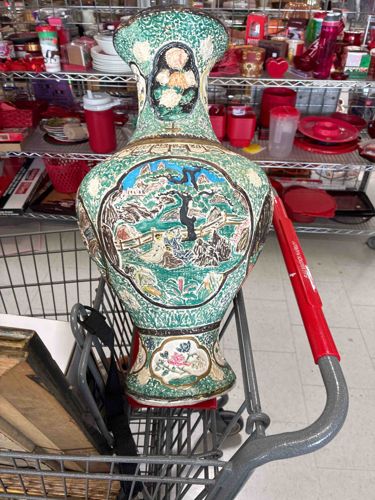
Large Cloisonné Enamel Baluster Vase
This appears to be a large, elaborately decorated cloisonné enamel vase, likely of Chinese origin. The dominant colors are various shades of green, particularly a mottled, textured teal or light jade green that covers much of the surface. The vase has a classic baluster form, with a flared rim, a constricted neck, a broad shoulder tapering down to a narrower base, and a slightly splayed foot. The surface is heavily textured, likely due to the nature of cloisonné work where individual cells (cloisons) are filled with enamel. It features several distinct decorative panels or medallions. The central, largest medallion on the body depicts a detailed landscape scene, possibly with mountains, architecture (such as pagodas or houses), and trees, including a prominent gnarled black tree with blue foliage. The colors within this scene are vibrant, incorporating blues, browns, greens, and ochre tones. Above this main scene, on the neck, there's another panel featuring what appears to be a figure or perhaps a stylized floral design in tones of cream, gold, and perhaps subtle pinks, bordered by a darker frame. On the splayed foot, there's another smaller cartouche with floral motifs, including pink and blue flowers with green leaves on a cream background, again bordered by a darker band. Metallic outlines (cloisons) are visible throughout, defining the intricate patterns and separating the enamel colors. These cloisons appear to be gold-toned, contributing to the item's opulent appearance. The overall condition suggests some wear consistent with age and handling. There isn't significant visible damage like cracks or major chips, but typical surface wear or minor losses to the enamel might be present upon closer inspection. The style, with its detailed pictorial scenes and extensive use of enamel, points towards a late 19th to mid-20th century production, possibly Republic Period or earlier, though without a clear mark, this is an estimate. The quality of the intricate detail and the vibrant color palette suggest a good level of craftsmanship.
AI-Generated Appraisal Disclaimer
Estimated Value
$1,800 - $2,500
Basic Information
Category
Decorative Arts/Vase
Appraised On
December 4, 2025
Estimated Value
$1,800 - $2,500
Item Description
This appears to be a large, elaborately decorated cloisonné enamel vase, likely of Chinese origin. The dominant colors are various shades of green, particularly a mottled, textured teal or light jade green that covers much of the surface. The vase has a classic baluster form, with a flared rim, a constricted neck, a broad shoulder tapering down to a narrower base, and a slightly splayed foot. The surface is heavily textured, likely due to the nature of cloisonné work where individual cells (cloisons) are filled with enamel. It features several distinct decorative panels or medallions. The central, largest medallion on the body depicts a detailed landscape scene, possibly with mountains, architecture (such as pagodas or houses), and trees, including a prominent gnarled black tree with blue foliage. The colors within this scene are vibrant, incorporating blues, browns, greens, and ochre tones. Above this main scene, on the neck, there's another panel featuring what appears to be a figure or perhaps a stylized floral design in tones of cream, gold, and perhaps subtle pinks, bordered by a darker frame. On the splayed foot, there's another smaller cartouche with floral motifs, including pink and blue flowers with green leaves on a cream background, again bordered by a darker band. Metallic outlines (cloisons) are visible throughout, defining the intricate patterns and separating the enamel colors. These cloisons appear to be gold-toned, contributing to the item's opulent appearance. The overall condition suggests some wear consistent with age and handling. There isn't significant visible damage like cracks or major chips, but typical surface wear or minor losses to the enamel might be present upon closer inspection. The style, with its detailed pictorial scenes and extensive use of enamel, points towards a late 19th to mid-20th century production, possibly Republic Period or earlier, though without a clear mark, this is an estimate. The quality of the intricate detail and the vibrant color palette suggest a good level of craftsmanship.
Related Tags
Get Your Items Appraised
Instant estimates of your treasures with AI-powered instant appraisals